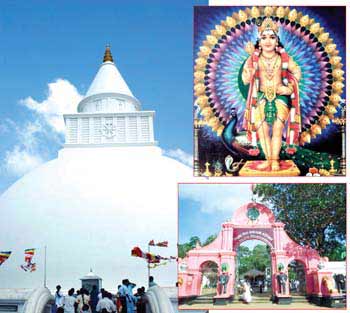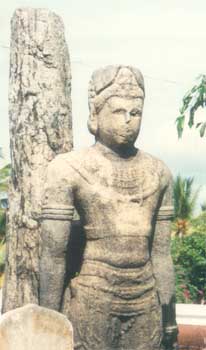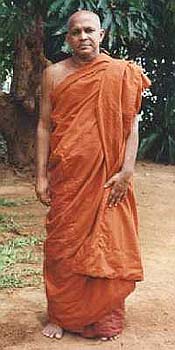Kiri Vehera
Kiri Vehera is one of the five most important sites of worship in the city along with the Maha Bodhi, Kataragama Devale, Sella Kataragama and Vedihitikanda. The dagoba is also described in the stanzas as one of 16 most important pilgrimage sites in Sri Lanka
The 95 ft. tall Kiri Vehera has a circumference of 280 feet. It is milky white in colour, hence the name. It is situated near the well known Menik Ganga.
There are many theories on the origin of the dagoba. Some believe it was built by Parakramabahu the Great of Polonnaruwa during the Third Century BC, on the request of Queen Subadra. Some think that it was first built by a local ruler named Mahasena on a site made hallowed by the Buddha's visit.
Some believe that the vihara was originally known as Magul Maha Seya and although there are no clues as to who built it, the bricks used in the construction bear Brahmin inscriptions which point to King Mahanaga's reign during the Third Century BC. Some records even date it to the first century BC.
The Buddha is believed to have paid a visit to Kataragama during His third visit to Sri Lanka. The Kiri Vehera is said to enshrine the golden seat the Buddha sat on during His sermon, a lock of His hair and the royal sword magul kaduwa with which Prince Siddhartha cut off His hair at the Great Renunciation.
God Skanda
One beautiful story states that the God Skanda (Kataragama) shot an arrow from the Vedihitikanda (peak) vowing that where the arrow hit, there a temple would be built.
The place is also linked to the reign of Dappula I, Vijayabahu I and Kavantissa, the father of King Dutugemunu and Saddhatissa. However, the Kiri Vehera went into ruin with jungles covering much of the area after the Chola invasions of Polonnaruwa in the 12th century. A renovation programme was carried out at Kiri Vehera in 1912 and again in 1970.
While the Dalada Perahera ranks on top, the Kataragama festival is extremely important amongst the country's social and cultural events possibly because it amalgamates all races and religions to one spot.
The predominantly Hindu festival, conducted during July-August, contains some novel features such as kavadi dancers and fire walkers. It ends with a glittering perahera where elephants, chieftains, drummers and up country and low country dancers play a leading role. All Buddhists pay a visit to Kiri Vehera after the festival, and in most cases, before as well.
According to Ven. Soratha Thero of the Kataragama Kiri Vehera Devalaya Lord Buddha visited 16 places in Sri Lanka including Kataragama, and was graciously welcomed by the local ruler Mahasena or Mahagosha, who later became a disciple.
Legend has it that Mahasena, having taken refuge in the triple gem, vowed to remain and protect Buddhism in Sri Lanka.
Bodhisattva
Many Buddhists believe that God Kataragama is a Bodhisattva (one aspiring to be a Buddha) who has the power and compassion to intervene in the lives of those who appeal to him. While some scholars are of the opinion that God Kataragama was a local chieftain who was later elevated to the status of a deva, others proclaim Mahasena is still alive and rules to this day.
Local folklore aside though, the belief in the god and the reverence for the Kiri Vehera are deeply ingrained in the hearts of the people of Sri Lanka, and the deity and place of worship are one of the first things that come to mind in times of strife.
God Skanda is said to be one of the four deities guarding the Sinhala pantheon though he is originally a vedic god.
If ever there was proof that the so-called Sinhala and Hindu cultures are intricately and inextricably interwoven, Kataragama perhaps above anything else, stands for it.



